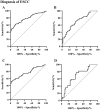Serum insulin-like growth factor binding protein-3 as a potential biomarker for diagnosis and prognosis of oesophageal squamous cell carcinoma
- PMID: 35930383
- PMCID: PMC9359171
- DOI: 10.1080/07853890.2022.2104921
Serum insulin-like growth factor binding protein-3 as a potential biomarker for diagnosis and prognosis of oesophageal squamous cell carcinoma
Abstract
Background: Insulin-like growth factor binding protein-3 (IGFBP3) has been reported to be related to the risk of some cancers. Here we focussed on serum IGFBP3 as a possible biomarker of diagnosis and prognosis for oesophageal squamous carcinoma (ESCC).
Methods: Enzyme-linked immunosorbent assay (ELISA) was used to measure the serum IGFBP3 level in the training cohort including 136 ESCC patients and 119 normal controls and the validation cohort with 55 ESCC patients and 42 normal controls. The receiver operating characteristics curve (ROC) was used to assess the diagnosis value. Cox proportional hazards model was applied to select factors for survival nomogram construction.
Results: Serum IGFBP3 levels were significantly lower in early-stage ESCC or ESCC patients than those in normal controls (p < .05). The specificity and sensitivity of serum IGFBP3 for the diagnosis of ESCC were 95.80% and 50.00%, respectively, with the area under the ROC curve (AUC) of 0.788 in the training cohort. Similar results were observed in the validation cohort (88.10%, 38.18%, and 0.710). Importantly, serum IGFBP3 could also differentiate early-stage ESCC from controls (95.80%, 52.54%, 0.777 and 88.10%, 36.36%, 0.695 in training and validation cohorts, respectively). Furthermore, Cox multivariate analysis revealed that serum IGFBP3 was an independent prognostic risk factor (HR = 2.599, p = .002). Lower serum IGFBP3 level was correlated with reduced overall survival (p < .05). Nomogram based on serum IGFBP3, TNM stage, and tumour size improved the prognostic prediction of ESCC with a concordance index of 0.715.
Conclusion: We demonstrated that serum IGFBP3 was a potential biomarker of diagnosis and prognosis for ESCC. Meanwhile, the nomogram might help predict the prognosis of ESCC. Key MessageSerum IGFBP3 showed early diagnostic value in oesophageal squamous cell carcinoma with independent cohort validation. Moreover, serum IGFBP3 was identified as an independent prognostic risk factor, which was used to construct a nomogram with improved prognosis ability in oesophageal squamous cell carcinoma.
Keywords: ESCC serum biomarker; Serum insulin-like growth factor binding protein-3; diagnosis and prognosis; oesophageal squamous cell carcinoma.
Conflict of interest statement
No potential conflict of interest was reported by the authors.
Figures









Similar articles
-
Serum insulin-like growth factor binding protein 3 as a promising diagnostic and prognostic biomarker in esophagogastric junction adenocarcinoma.Discov Oncol. 2022 Nov 21;13(1):128. doi: 10.1007/s12672-022-00591-1. Discov Oncol. 2022. PMID: 36409444 Free PMC article.
-
Prognostic and diagnostic potential of miR-146a in oesophageal squamous cell carcinoma.Br J Cancer. 2016 Feb 2;114(3):290-7. doi: 10.1038/bjc.2015.463. Epub 2016 Jan 21. Br J Cancer. 2016. PMID: 26794279 Free PMC article.
-
Combined detection of serum Dickkopf-1 and its autoantibodies to diagnose esophageal squamous cell carcinoma.Cancer Med. 2016 Jul;5(7):1388-96. doi: 10.1002/cam4.702. Epub 2016 Mar 14. Cancer Med. 2016. PMID: 26988995 Free PMC article.
-
Prognostic nomogram and risk factors for predicting survival in patients with pT2N0M0 esophageal squamous carcinoma.Sci Rep. 2023 Mar 26;13(1):4931. doi: 10.1038/s41598-023-32171-w. Sci Rep. 2023. PMID: 36967413 Free PMC article. Review.
-
Blood-based biomarkers for early detection of esophageal squamous cell carcinoma.World J Gastroenterol. 2020 Apr 21;26(15):1708-1725. doi: 10.3748/wjg.v26.i15.1708. World J Gastroenterol. 2020. PMID: 32351288 Free PMC article. Review.
Cited by
-
Multi-omics characterization of esophageal squamous cell carcinoma identifies molecular subtypes and therapeutic targets.JCI Insight. 2024 Apr 23;9(10):e171916. doi: 10.1172/jci.insight.171916. JCI Insight. 2024. PMID: 38652547 Free PMC article.
-
IGFBP3 modulation of tumor pathogenesis and cell signaling pathways (Review).Oncol Lett. 2025 Jun 3;30(2):379. doi: 10.3892/ol.2025.15125. eCollection 2025 Aug. Oncol Lett. 2025. PMID: 40503041 Free PMC article. Review.
-
Serum IGFBP-1 as a promising diagnostic and prognostic biomarker for colorectal cancer.Sci Rep. 2024 Jan 22;14(1):1839. doi: 10.1038/s41598-024-52220-2. Sci Rep. 2024. PMID: 38246959 Free PMC article.
-
The role of IGFBP-3 in tumor development and progression: enlightenment for diagnosis and treatment.Med Oncol. 2024 May 7;41(6):141. doi: 10.1007/s12032-024-02373-x. Med Oncol. 2024. PMID: 38714554 Review.
-
Expression of Salivary and Serum IGF-1 and IGFBP-3 in Individuals With Diabetes and Oral Cancer.J Maxillofac Oral Surg. 2025 Apr;24(2):432-440. doi: 10.1007/s12663-024-02212-6. Epub 2024 May 24. J Maxillofac Oral Surg. 2025. PMID: 40182453
References
-
- Sung H, Ferlay J, Siegel RL, et al. . Global cancer statistics 2020: GLOBOCAN estimates of incidence and mortality worldwide for 36 cancers in 185 countries. CA A Cancer J Clin. 2021;71(3):209–249. - PubMed
-
- Pennathur A, Gibson MK, Jobe BA, et al. . Oesophageal carcinoma. Lancet (London, England). 2013;381(9864):400–412. - PubMed
-
- Enzinger PC, Mayer RJ.. Esophageal cancer. N Engl J Med. 2003;349(23):2241–2252. - PubMed
-
- Reichenbach ZW, Murray MG, Saxena R, et al. . Clinical and translational advances in esophageal squamous cell carcinoma. Adv Cancer Res. 2019;144:95–135. - PubMed
Publication types
MeSH terms
Substances
LinkOut - more resources
Full Text Sources
Medical
Miscellaneous
